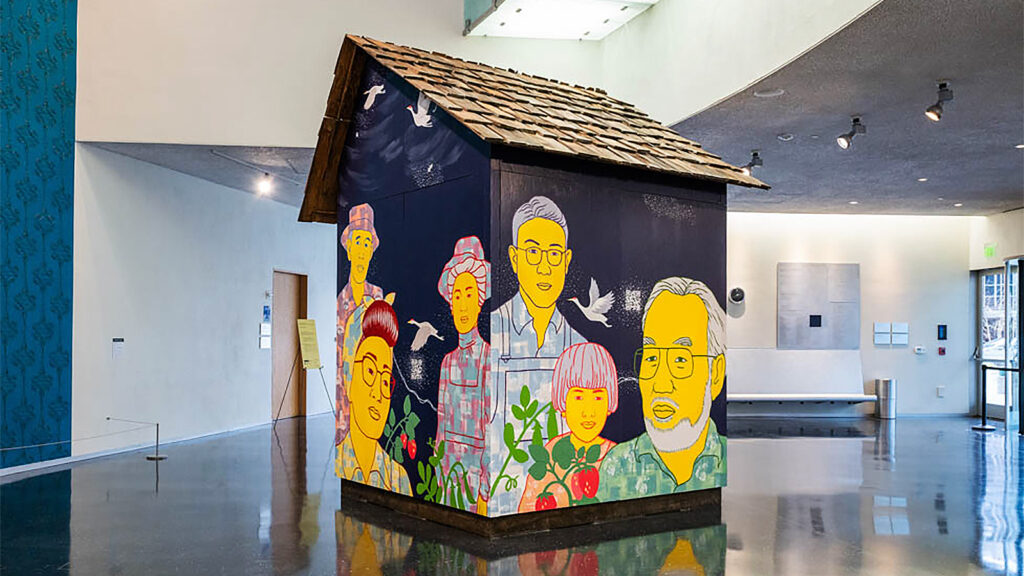Last year, when Meta commissioned Michelle Kumata to create a mural for its Bellevue, Washington offices, the artist saw an opportunity to surface the region’s lesser-seen history. More than half a century ago, the area around Meta’s Bellevue HQ was farmland owned and tilled by Japanese-Americans who, during World War II, were forcibly stripped of their property and incarcerated in concentration camps. Kumata’s mural foregrounds these Japanese-American farmers in brightly hued large-scale portraits — a work that, last week, was expanded into an interactive augmented reality-powered (AR) experience at the Bellevue Arts Museum.
What happened

Installed at the Bellevue Arts Museum, Kumata’s work uses AR to deepen its storytelling. Image: Installation view of “Emerging Radiance,” Bellevue Arts Museum
On view until March 13, Kumata’s Meta-commissioned mural, “Emerging Radiance: Honoring the Nikkei Farmers of Bellevue,” has been reimagined and repainted onto a hand-built farmhouse, located in the museum’s public forum space. Launched alongside the 80th anniversary of Executive Order 9066, which authorized the detention of Japanese-Americans, the work also encompasses a deeper storytelling element with an assist from AR.
Onsite viewers can point their smartphone cameras at QR codes integrated into the murals to access Instagram filters with which they can “meet” the farmers behind three portraits. These animated subjects offer stories of their incarceration, testimonies gathered from video interviews with Tosh Ito, Rae Matsuoka Takekawa, and Mitsuko Hashiguchi, which are held in the archives of non-profit organization Densho. The experience was produced by immersive experience studio Invisible Thread using Spark AR, in partnership with Kumata and creative director Tani Ikeda.
Why it matters

Viewers of the onsite work simply scan a QR code to unlock Instagram filters that animate the testimonies of Nikkei farmers. Image: Bellevue Arts Museum / Meta
More than novel playthings, creative technologies like AR and VR open for artists and institutions new avenues into storytelling and education. Like “Emerging Radiance,” projects such as Levine Museum’s KnowCLT app and Illinois Holocaust Museum’s The Journey Back VR exhibition offer fresh ways to engage audiences, but also, to preserve historical narratives.
As a work commissioned by Meta, the experience bears out the company’s continued participation in the cultural realm, particularly with its Meta Open Arts program (previously Facebook Open Arts). Over a decade, the residency has enlisted some 1,000 artists to create works for its offices, with plans to further grow its footprint. Most recently, Meta Open Arts announced upcoming partnerships with museums including the New Museum, Park Avenue Armory, and the Institute of Contemporary Art San Francisco — collaborations that are bound to deepen the exchange between the cultural and technology sectors.
What they said
“So many of these stories of incarceration are lost and will be lost with this older generation… I feel like the farmhouse is a container for the stories and experiences, but then there are these bright, glowing portraits that come alive to help our community heal by sharing their stories of strength and resilience.” — Michelle Kumata, Artist
“It was such an honor to commission this work and bring these important stories to the Bellevue community and beyond. I am grateful to the artists and community members who are demonstrating the power of art to connect generations and shining light on the role technology can play for us to reflect on our past and the future we want to build.” — Tamar Benzikry, Curator, Meta Open Arts



